Discovering Abu Dhabi's Souks: Culture and Commerce
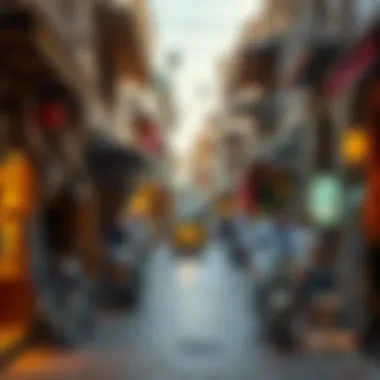
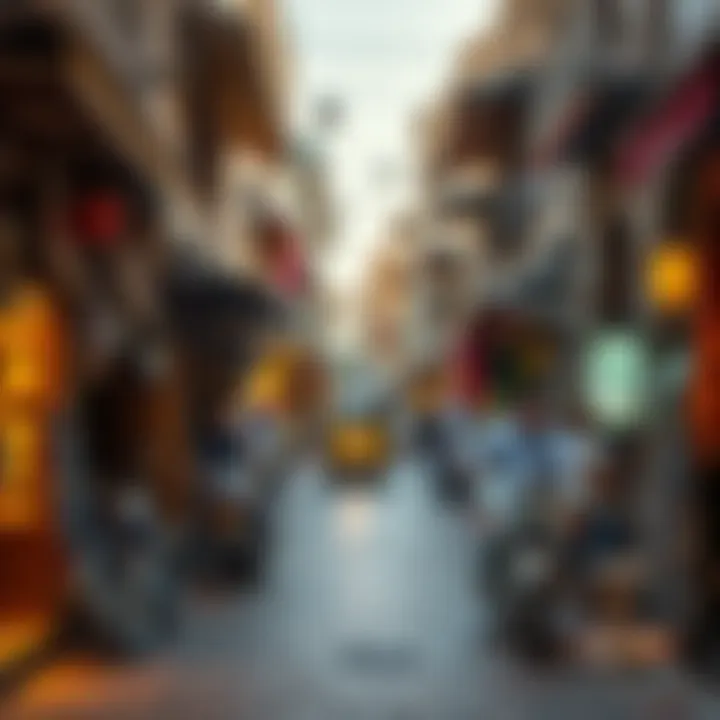
Intro
The souks in Abu Dhabi represent more than just shopping hotspots; they are a microcosm of the city's blend of tradition and modernity. Walking through these vibrant markets, you can feel the weight of history in the air, mingling with the fragrant scents of spices and local delicacies. Each souk tells a story, from the intricately crafted goods that line the stalls to the interactions between vendors and customers, which have endured for generations.
In this journey, you'll uncover the essence of these marketplaces. Dive into their historical roots, unique cultural offerings, and how they’ve adapted to the modern era. Whether you're a seasoned bargain hunter, a curious traveler, or someone intrigued by the interplay of old and new, this exploration will expand your understanding of Abu Dhabi’s unique shopping experience.
Not only will you discover the bustling atmosphere and the array of products—from handmade crafts to lush textiles—but you'll also get a taste of local culinary traditions that are intrinsically tied to these markets. By the end of this journey, you will grasp how souks stand as vital threads in the fabric of Abu Dhabi’s urban landscape, embodying the spirit of the past while embracing the future.
Let's step through the narrow alleys of the souks and see what secrets await us.
Market Trends
As the world evolves, so do the markets. The souks of Abu Dhabi have seen significant transformation over the years. They remain a vibrant blend of tradition and modern trends. With a keen understanding of the current landscape, we can better appreciate how these markets cater to both locals and tourists alike.
Current Real Estate Landscape
The real estate market in and around the souks has undergone substantial changes. The demand for retail space in these areas reflects a broader trend of revitalization and investment. New developments blend seamlessly with historic architecture, creating an environment where one can appreciate the old while indulging in the new. This has attracted not just businesses but also tourists, keen to experience the unique atmosphere.
There’s a palpable excitement in the air. With establishments ranging from traditional handicrafts to modern cafes, the appeal resonates with a diverse audience. However, one must navigate the balance of preserving heritage while accommodating modern desires, which is at the heart of current market discussions.
Future Predictions and Insights
Looking ahead, the souks are poised for change. Enhanced digital connectivity will likely transform how transactions occur, with e-commerce playing a larger role. Moreover, sustainability is becoming a pressing concern. Vendors and consumers alike are leaning toward products that are environmentally friendly and ethically sourced.
Expect to see more initiatives focusing on local artisans, fostering a sense of community and tradition. The symbiosis between digital advancements and heritage crafts will bring a new dimension to the souk experience.
As urban development accelerates in Abu Dhabi, the souks have a unique opportunity to position themselves as cultural hubs that promote not just shopping, but a celebration of community and identity. With the fine balance of innovation and tradition, the future of these markets is bright, promising an exciting blend of cultural richness and modern convenience.
"The souks embody the pulse of Abu Dhabi, where each stall reflects a story waiting to be discovered."
Stay tuned as we explore more about the offerings in these fascinating markets, where the spirit of Abu Dhabi thrives.
Foreword to Souks in Abu Dhabi
The souks of Abu Dhabi serve as both cultural landmarks and bustling marketplaces, spotlighting a unique blend of tradition and modern life. They are not merely shopping venues; they are vibrant hubs where history, art, and commerce intertwine. Understanding these souks is essential to appreciate the pulse of life in the capital of the Emirate. The essence of Abu Dhabi’s heritage is often found in the intricacies of its souks, making this topic a pivotal part of exploring the city.
Historical Significance
Historically, souks have played a crucial role in shaping the economic and social fabric of Abu Dhabi. These traditional markets date back centuries, functioning as vital centers for trade where merchants exchanged goods ranging from spices and textiles to artisanal crafts. The evolution of these souks reflects the broader changes in the region, from a pearl diving economy to a contemporary commercial hub. Even today, you can feel the echoes of yesteryears as you walk through the narrow alleys filled with rich scents and vibrant colors.
A notable aspect of the souk’s history is how they helped foster community bonds. For instance, marketplaces were often where families gathered not just to shop but to connect with one another, share news, and celebrate cultural traditions. They have been the stage for storytelling, exchanging not just goods, but histories and ideas.
Cultural Overview
Culturally, the souks encapsulate the spirit of Abu Dhabi’s diverse society. Each souk is distinct, offering a variety of goods that reflect the region's rich heritage. For instance, the Souk Al Zafarana exemplifies the local craftsmanship with handmade items while exuding an air of authenticity with its traditional architecture. On the other hand, Souk Al Bahar is known for its upscale shopping experience, attracting those looking for luxury alongside traditional goods.
Visiting these souks isn’t just a shopping trip; it’s an immersion into the local way of life. The sounds and sights evoke a sense of nostalgia and excitement, showcasing everything from ornate jewelry to vibrant textiles. The synergy between the vendors and the shoppers brings to life the cultural tapestry of Abu Dhabi. Whether you are sipping on aromatic coffee or haggling over handcrafted items, each moment spent in the souks adds a layer to your understanding of the Emirati culture.
The souks of Abu Dhabi are not merely places for transactions; they are living museums that tell the stories of a people, their heritage, and their evolution in a rapidly changing world.
Types of Souks
In the vibrant tapestry of Abu Dhabi, the souks are not just mere markets; they are the heart and soul of the city’s cultural and commercial life. These marketplace hubs tell stories of the past while embracing present-day trade. They offer a mix of traditional charm and modern convenience, showcasing a variety of goods and services that cater to both residents and visitors. \n\nThe contrast between traditional and modern souks in Abu Dhabi highlights the city's evolution, making it essential for anyone exploring this landscape to understand what each type has to offer.
Traditional Souks
Souk Al Zafarana
One of the classic examples of a traditional souk is Souk Al Zafarana. Nestled in one of the older parts of the city, this souk reflects the rich history and culture of Abu Dhabi. It is popular for its aromatic spices and herbs that fill the air with enticing fragrances, attracting food lovers and amateur chefs alike. The key characteristic of Souk Al Zafarana is its emphasis on authentic products.
It stands out as a well-loved choice for those looking to dive deep into the local culinary traditions. One unique feature is that many vendors are eager to share their knowledge about the spices, fostering an atmosphere of education and discovery. However, the narrow aisles can make navigation a bit tricky, especially during busy hours. This lends a certain charm to the experience, but visitors should keep their wits about them to avoid overcrowding.
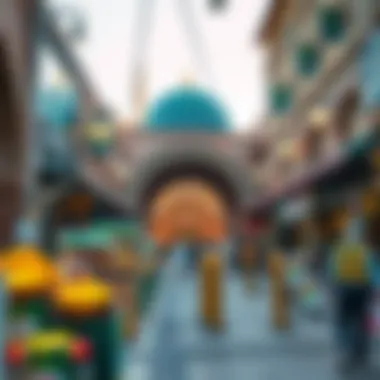
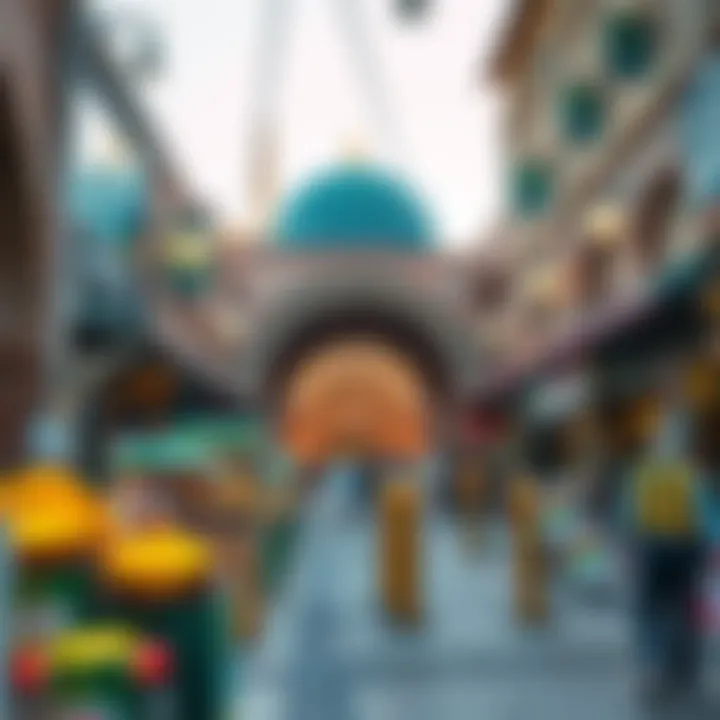
Souk Al Bahar
Another gem is Souk Al Bahar, which enchants visitors with its blend of old-world charm and contemporary design. Set alongside a picturesque waterfront, this souk is known for its arts and crafts, including intricate ceramics and beautifully woven textiles. What makes Al Bahar appealing is its accessibility; it’s often buzzing with families and tourists alike, making it a sociable spot for mingling.
Al Bahar features an open-air layout, allowing for a casual stroll while soaking in the sights and sounds around. A disadvantage, however, is that its popularity sometimes leads to inflated prices, as competition among vendors diminishes. Even so, the experience of browsing the arts while enjoying the views is worthy of the visit.
Modern Souks
Emirates Palace Souk
On the flip side, the Emirates Palace Souk offers a more luxurious shopping experience. Located adjacent to one of the most iconic hotels in the world, it serves as a hub for high-end brands while retaining an inviting atmosphere. This souk is characterized by its elegant design and the selection of premium goods, including fashion, accessories, and gourmet food items.
For many, the Emirates Palace Souk is a beneficial stop because it provides a glimpse into the modern opulence that Abu Dhabi has embraced. A unique feature is the blend of local artisanal specialties with international luxury items, making it an all-encompassing shopping destination. However, the elevated prices may deter those seeking more affordable options.
Galleria Mall
Lastly, Galleria Mall represents the pinnacle of modern shopping innovation in Abu Dhabi. This mall goes beyond mere shopping; it offers a complete leisure experience with dining, entertainment, and retail all under one roof. What sets Galleria apart is its commitment to hosting events that celebrate local culture, thus bridging the gap between tradition and modernity.
While Galleria attracts a younger crowd with its trendy shops and lively atmosphere, some may argue that it lacks the authentic souk feel found in traditional markets. Nevertheless, it remains a popular destination for a broad audience due to its vastness and variety, catering to just about every taste under the sun.
The richness of Abu Dhabi’s souks offers an enriching journey through its past and present. They provide not just products but also experiences that reflect the city’s identity.
Key Products and Crafts
The souks of Abu Dhabi are not just shopping venues; they are vibrant representations of the region's rich culture and tradition. The types of products and crafts available tell stories of the past while also illustrating the present. From intricate handicrafts to textiles, the offerings in these markets capture the essence of Emirati heritage and craftsmanship. Understanding these key products can deepen the appreciation for both the market and the culture as a whole.
Local Handicrafts
When wandering through the souks, you might stumble upon incredible local handicrafts that are both functional and decorative. These items often carry a sense of identity and history. For example, the Kandura, a traditional garment, is not just a piece of clothing; it symbolizes cultural pride and heritage. Local artisans take great pride in creating handicrafts using age-old techniques that have been passed down through generations.
Items like hand-carved wooden stools, woven baskets, or intricately designed pottery can make for fantastic souvenirs while embodying the work of skilled craftspeople. These unique products often reflect the local environment; a beautiful piece of pottery might showcase patterns inspired by the desert landscape or the coastal waters. Bringing one of these items into your home is like taking a slice of Abu Dhabi's artistic culture with you.
Textiles and Clothing
Textiles are another key area of focus in Abu Dhabi's souks. They come in various forms, including traditional clothing, fabrics, and accessories. The souks offer a rich assortment of colorful silks, printed cottons, and beautifully embroidered fabrics. The craftsmanship involved in producing these textiles deserves particular mention; each piece can take hours of intricate handiwork.
One highlight is the Hijab, available in countless designs, allowing individuals to express their personal style while adhering to cultural norms. Beyond traditional garments, shops often feature contemporary designs that appeal to both locals and tourists, fusing modern aesthetics with traditional flair. Another popular product is the Abaya, which comes in many styles and designs, combining elegance with modesty. Shopping for textiles in these markets allows visitors to not only purchase beautiful items but also support local textile artisans.
Jewelry and Accessories
When it comes to jewelry, the souks in Abu Dhabi do not disappoint. Ranging from handcrafted pieces to modern designs, the variety is splendid. Gold is particularly popular, and many shops display elegant gold items that draw attention from passersby. Traditional pieces like the Mandoos, an ornate jewelry box that often holds treasures, represent a deeper cultural significance.
The craftsmanship in jewelry-making here is remarkable. Jewelers often use gemstones like agate, pearls, and even diamonds, allowing for customization based on the buyer’s preference. It’s not simply the act of shopping; it’s an experience where you might find something truly special for yourself or a loved one. In fact, many artisans are open to discussing their techniques, potentially giving you insight into the craftsmanship behind each piece.
"In the souks, every craft has a story, and every product speaks to the heart of Emirati culture."
While exploring the souks, it's essential to take your time and appreciate the artistry behind these key products. Each item holds a piece of Abu Dhabi's soul, making them more than mere commodities but rather tokens of cultural heritage.
Culinary Highlights of the Souks
The souks of Abu Dhabi are not just about shopping; they offer a feast for the senses. Culinary highlights play a crucial role in these bustling marketplaces, showcasing the richness of local flavors while providing insight into the region's heritage. When wandering through the narrow lanes lined with colorful stalls, the enticing aromas wafting through the air speak volumes about the cultural diversity and culinary traditions that thrive here. Visitors get to experience a tasteful blend of spices, fresh ingredients, and age-old recipes that have been passed down through generations.
From savory dishes to sweet treats, the souks serve as a vibrant hub for food enthusiasts. This section explores the various local delicacies that capture the essence of Emirati cuisine, while also delving into the street food culture, offering a hands-on experience of how locals and tourists alike interact with this delicious landscape.
Local Delicacies
Local delicacies in Abu Dhabi’s souks are truly a gastronomic adventure, showcasing not just the flavors but also the stories behind the dishes. A variety of traditional meals are available, ranging from shawarma to falafel, each prepared with a local twist.
- Harees - This dish is made from wheat and meat, often flavored with spices. During Ramadan, it becomes especially popular, representing community and sharing.
- Al Majboos - A fragrant rice dish mixed with meat and a medley of spices, inviting many to gather around the table, reflecting Emirati hospitality.
- Knafa - A dessert that stands out, made with thin pastry, soaked in syrup and layered with cheese or cream—a perfect finish to any meal.
These dishes not only satisfy hunger but also connect visitors to the past. Eating what locals have enjoyed for years often feels like a rite of passage, immersing one in the heart of Emirati culture. Little food stalls allow for conversation as well, creating a sense of community among those dining together.
Street Food Culture
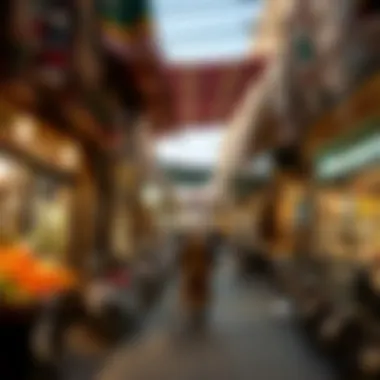
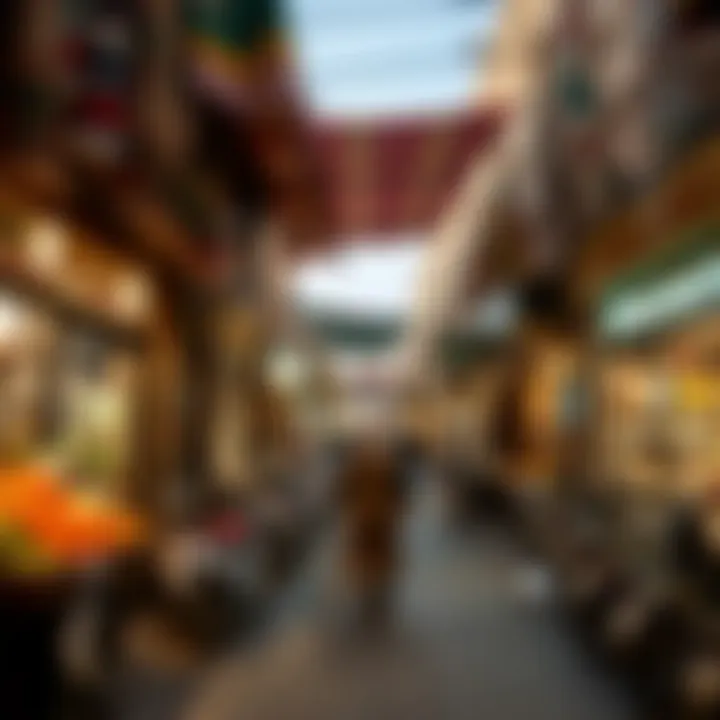
Street food is the pulse of any city, and Abu Dhabi’s souks are no exception. The unique street food culture offers quick bites that embody the emotive aspect of eating, often enjoyed while leaning against one of the many stalls. It’s about convenience, flavor, and often, a bit of chaos.
- You can find samosas hot and crispy, ready to be devoured with a side of tangy tamarind sauce.
- Mandi, a spiced rice and meat dish served with a dash of creativity, has forged a place as a fan favorite, often drawing a crowd hungry for its robust flavors.
In each souk corner, locals and expatriates congregate, sharing laughter and stories over plates of food. Street food is often seen as the melting pot of culture, where everyone comes together, fostering an inviting atmosphere. The price of street food is not just its affordability but also its intimate connection to everyday life in Abu Dhabi.
In essence, the culinary landscape of Abu Dhabi’s souks is about more than just sustenance; it represents shared experiences, cultural aesthetics, and a deep-rooted connection to community life. Visitors leave not only with a full stomach but with memories of flavors that linger long after their journey ends.
Experiencing the Souk Atmosphere
The thrill of the souk experience goes beyond mere shopping. It encapsulates a blend of sights, sounds, and interactions that breathe life into the marketplace. Understanding how this atmosphere plays a pivotal role not only enriches your visit but also enhances your appreciation of Abu Dhabi’s heritage. A journey through the souks offers a sensory feast—and digging deeper into ambiance and social dynamics helps in grasping its significance.
Ambiance and Architecture
When stepping into an Abu Dhabi souk, the first factor that captivates is the ambiance. Each souk tells a story through its architectural style, often mirroring classic Middle Eastern designs. Arched entrances, intricate tile work, and overhanging fabrics all mesh together, crafting a space that is both inviting and steeped in history.
The soft light filtering through fabric awnings contrasts with the vivid colors of spices and textiles on display, creating a warm environment. This aesthetic experience heightens the sensation of walking through a living museum, where shopping is secondary to soaking in the local culture.
It’s essential to notice the difference between traditional and modern souks. For instance, Souk Al Bahar boasts a contemporary flair, marrying traditional materials with modern design, whereas Souk Al Zafarana retains its heritage feel with rustic pathways and arrangements. Walking through these spaces isn’t just about purchasing—it’s about connecting with a visual narrative that spans generations.
**"The souk experience is about more than just commerce; it's a tapestry of culture, a dance between the past and the present."
It's worth considering the practical aspects of the atmosphere. The layout is often designed to encourage leisurely exploration. You might find narrow lanes inviting you to wander off the beaten path, discover new stalls, and engage with merchants who know their products inside and out. This invites conversations, often layered with tales steeped in local lore. Just the way the spaces are crafted naturally prompts you to lose track of time while fully immersing in the moment.
Social Dynamics
Social interactions set the tone for the souk experience. It’s a lively microcosm of Abu Dhabi's broader society, a blend of locals and expatriates coming together. This communal vibe can be felt in the bustling energy that flows through the market, very much tied to the commodities being sold—as well as the narrative that comes with them.
Merchants often engage visitors with a friendly demeanor, eager to explain their craftsmanship or share the significance of a particular item. It’s not uncommon to see customers bargaining; this age-old practice imbues a level of respect and understanding through negotiation. A simple transaction can transform into a cultural exchange, making it a unique opportunity to learn.
Interactions go beyond just buyer-seller relationships. Locals gather at these hubs to chat, sip on traditional Arabic coffee, and catch up on the latest community news. The souk becomes a meeting ground, and this very dynamic weaves a fabric of community engagement deeply rooted in cultural identity. The blending of generations—from elders sharing wisdom with the younger populace to families exploring the market together—captures the essence of everyday life in Abu Dhabi.
Visiting a souk is not just about transactional experiences but also navigating social landscapes, where every interaction contributes to a wider understanding of the local culture. It immerses you into the rich social tapestry of the city—not just as a tourist, but as a participant in a living culture.
Shopping Tips
Visiting the souks of Abu Dhabi can be a delightful experience, but knowing how to navigate them can make all the difference. This section tackles the crucial aspect of shopping, especially when it comes to making the most of your trip. Whether you're a first-time visitor or a seasoned traveler, understanding some shopping tips can significantly enhance your experience in these vibrant marketplaces.
Bargaining Techniques
When it comes to shopping in souks, haggling is almost an art form. Negotiating prices is expected and can be quite enjoyable if done respectfully. Here are some effective techniques:
- Start Low: It’s wise to begin negotiations well below the price you're willing to pay. This way, you can negotiate towards your target price comfortably.
- Know Your Limits: Decide beforehand your maximum spend on an item. Stick to this limit to avoid overspending in the heat of the moment.
- Build Rapport: Treat the vendor as a person, not just a seller. Engage in small talk or ask about their products. This can create a more amiable atmosphere for negotiation.
- Be Patient: Sometimes the vendor may not buzz right away with the price cuts. A little patience can go a long way in securing a better deal. Remember, you're not just buying goods; you're participating in a cultural exchange.
- Walk Away: If a vendor is firm on their price, don’t hesitate to walk away. Sometimes, this prompts them to call you back with a better offer, making a successful end to your bargaining session.
Utilizing these techniques can transform the sometimes intimidating experience of haggling into one that is rewarding and fun.
Best Times to Visit
Timing your visit to the souks can also impact your experience significantly. Here are some pointers on when to go:
- Early Morning Visits: Arriving at the souks when they first open, usually around 10 AM, can be quite ideal. The atmosphere is peaceful, and the vendors are generally more willing to negotiate.
- Late Afternoon: Another excellent time is later in the afternoon. This is when many locals start their shopping, adding to the cultural experience of mingling with residents.
- Weekdays over Weekends: If you want to avoid the crowds, visiting on weekdays can give you more space to browse and bargain at your leisure. Saturdays and Sundays tend to attract more tourists and families.
- Avoiding Midday Heat: During the hotter months, temperatures can soar. It’s best to schedule your shopping trips either early or in the late afternoon to skip the blistering sun.
Planning your visit around these tips can make the experience less chaotic and more enjoyable, allowing you to soak in the atmosphere and variety the souks have to offer.
Souks as Community Hubs
Souks in Abu Dhabi serve as more than just marketplaces; they are integral to the cultural and social fabric of the community. The lively atmosphere pulsating through the narrow alleyways fosters interactions that transcend simple economic transactions. Tourists and locals mingle, creating a harmonious blend of universal experiences that enrich the urban tapestry. This dynamic environment is particularly valuable as it enhances community bonding and strengthens cultural identity.
Cultural Events and Festivals
The souks are often the epicenter for various cultural events and festivals, showcasing the rich heritage of the region. Events such as the Abu Dhabi International Book Fair and local arts festivals convert the souks into stages that celebrate tradition through music, dance, and art. These gatherings not only attract visitors but also encourage residents to rediscover their cultural roots. Such occasions provide a platform for local artists and craftspeople to exhibit their skills, thereby stimulating community pride.
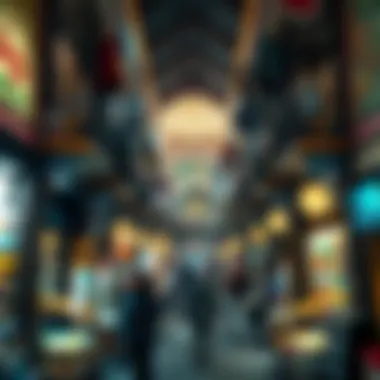
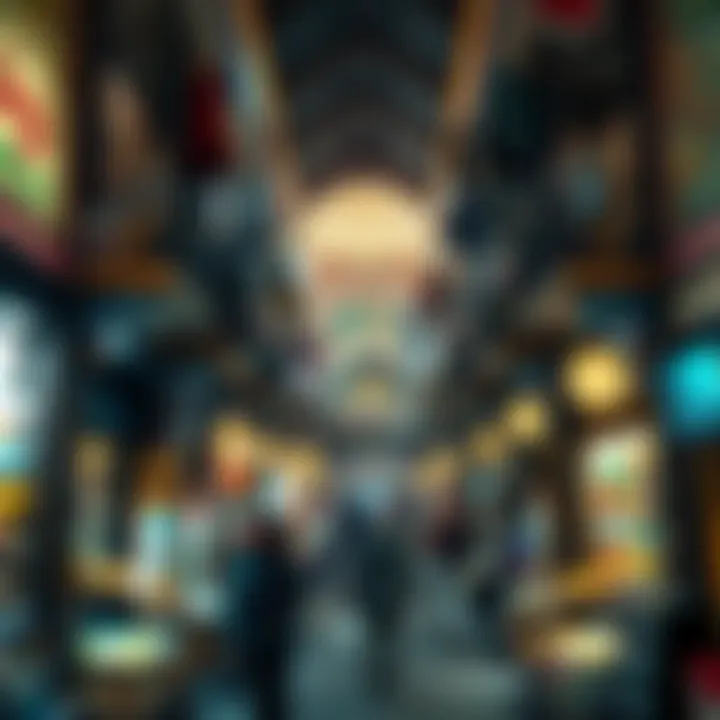
Some specific events include:
- National Day Celebrations: Marking the unification of the Emirates with lively performances and traditional music.
- Eid Markets: During the festive periods, the souks are adorned beautifully, attracting families looking for special items and celebrating together.
- Cultural Heritage Days: These days witness artisans demonstrating traditional crafts like weaving or pottery, creating an interactive learning experience for attendees.
In addition to these, themed markets highlighting local gastronomy provide a taste of the Emirati culinary landscape.
Meeting Places for Locals
Moreover, souks function as essential meeting places for locals. Beyond shopping, these marketplaces are social hubs where people gather to catch up, discuss daily life, or simply enjoy a cup of traditional Arabic coffee. The informal seating areas scattered throughout promote casual conversations, fostering friendships and community ties.
The appeal of a souk extends to all demographics:
- For Families: It offers a safe, vibrant space for children to learn about their heritage while they play.
- For Young Adults: It becomes a trendy spot to socialize and explore new tastes ranging from modern to traditional delicacies.
- For the Elderly: It serves as a cultural memory lane where stories of the past can be shared, and local wisdom can be passed down to younger generations.
The combination of commerce, culture, and collaboration makes the souks pivotal in shaping community spirit. Their role in social and cultural exchanges cannot be underestimated, serving as hubs where people come together, rooted in tradition yet welcoming modern influences.
"Souks are where the heart meets commerce; they are more than just places to shop but spaces to connect, learn, and grow."
Future of Souks in Abu Dhabi
The souks of Abu Dhabi are not just bustling marketplaces; they embody a rich history and vibrant culture. As the city evolves, so too do these commercial hubs. Understanding the future of the souks is essential for anyone interested in the intersection of tradition and modern development. This transition isn't merely about retaining relics of the past; it’s about adapting to the changing needs of a diverse population while still respecting the cultural heritage that defines this unique trading environment.
Modernization Efforts
The modernization of souks in Abu Dhabi presents a fascinating case study in balancing progress with preservation. Investment in infrastructure is on the rise, transforming these historic sites to meet contemporary expectations while trying to maintain their authenticity. For instance, new layout designs aim to enhance traffic flow, making it easier for tourists and locals alike to navigate through the colorful stalls.
Automated payment systems are also being introduced, streamlining the shopping experience while appealing to younger generations accustomed to digital transactions.
However, modernization isn't just about technology; it influences the types of products available. Souks now feature a blend of traditional handicrafts alongside modern artisan creations, catering to a wide audience from expats looking for unique finds to investors in search of quality goods.
The effort to modernize includes:
- Upgraded Facilities: Improved restrooms, seating areas, and food courts that reflect modern consumer preferences.
- Sustainability Initiatives: Green spaces and eco-friendly practices are gaining traction, aligning with global movements towards sustainability.
- Enhanced Marketing: Use of social media platforms such as Instagram and Facebook has been embraced to attract a broader audience, particularly younger shoppers looking for unique experiences.
Preserving Tradition in Innovation
Amid these changes, there's a crucial emphasis on preserving the traditions that make the souks special. Active participation from local artisans is encouraged to maintain the authenticity of the crafts offered. Workshops and demonstrations are now part of the souk experience, allowing visitors to learn directly from skilled craftsmen. This hands-on approach creates a deeper connection to the heritage of Abu Dhabi, ensuring that the essence of the souks remains intact.
Also noteworthy is the role of community events in maintaining cultural ties. Festivals that celebrate local crafts, cuisine, and music often take place within the souks, drawing in both residents and tourists. These events serve as reminders of the rich cultural lineage and foster a sense of belonging among locals.
In addition, several initiatives focus on educating visitors about the historical significance behind various artifacts and products sold in these markets. Guided tours engage tourists with stories that breathe life into what they’re purchasing, making every buy more than just a transaction.
To summarize, the future of souks in Abu Dhabi lies in a delicate balance between modernization and tradition. As elements of advanced commerce are integrated, a strong commitment to cultural preservation ensures that these marketplaces remain an essential thread in the city's vibrant tapestry.
"The souk is not merely a place for buying and selling; it’s a living museum of culture and tradition that welcomes the world with open arms."
By fostering this dual approach, Abu Dhabi can continue to embrace its past while stepping confidently into the future.
Epilogue
The exploration of Abu Dhabi's souks transcends mere shopping; it encapsulates a vibrant cultural heritage that holds significance in today's fast-paced world. Souks serve as a tangible link to the past, showcasing the unique fusion of tradition with contemporary commerce. They are places where art, history, and community intersect, offering visitors a gateway to the region's customs and daily life.
Reflections on Cultural Heritage
The very fabric of Abu Dhabi is stitched with rich cultural threads that the souks proudly exhibit. Each stall, each rug, and every piece of jewelry tells a story—not just of craftsmanship, but of generations who have passed down skills and knowledge through ages. For instance, one can observe local artisans carefully weaving intricate patterns into textiles, or the delicate art of creating mesmerizing gold jewelry. It's more than just shopping; it's an invitation to engage with history and gather tales that live within these walls, echoing the voices of the past.
Moreover, these bustling marketplaces are often painted with festivals and events that celebrate Emirati culture, enriching the experiences of both locals and travelers. Festivals like Eid often see souks come alive with traditional performances, enhancing the connection to cultural rituals.
Significance for Residents and Tourists
For residents, souks are not merely commercial hubs; they foster a sense of community. Meeting places for friends and family, the souks serve as social gatherings where people share experiences, exchange news, and enjoy cultural performances. They are, in many ways, the heartbeat of the local community.
For tourists, the souks present an invaluable opportunity to experience the authentic culture of Abu Dhabi. Visitors can indulge in local delicacies, engage in conversations with stall owners, and take home unique handcrafted goods that embody the local identity. This authentic experience fosters a deeper appreciation for the Emirati way of life.
In essence, the journey through Abu Dhabi's souks offers a mosaic of cultural dialogue—one that enriches the understanding of the region's heritage for both tourists and residents alike. The significance is clear: these markets not only celebrate the past but are also pivotal in shaping the future of Abu Dhabi's evolving identity.
"The souks are not just places to shop; they are where lives intertwine and cultures emerge, reflecting the spirit of Abu Dhabi."
For those interested in experiencing this rich tapestry, there is no better way than wandering through these markets, letting the sights and sounds guide the way to discovery.



